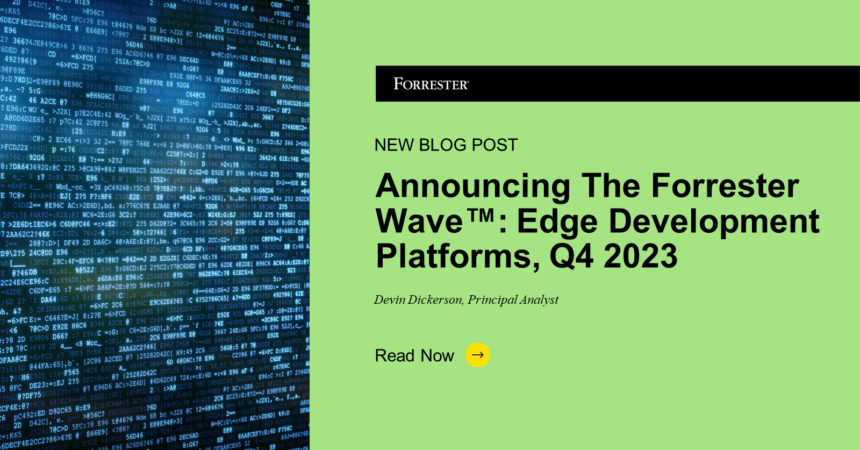A new internet is rising. As customers seek faster, more dynamic digital experiences, businesses must build applications capable of serving those customers with lower latency and with personalized and geographically relevant content. Emerging use cases in internet of things and artificial intelligence bring into focus the importance of how vast, geographically dispersed data sets can deliver powerful capabilities and insights. Distributed applications are transforming employee and consumer experiences in retail and manufacturing and delivering next-generation technology in autonomous vehicles and aerospace. Forward-leaning enterprises are applying the lessons learned from their cloud-native app modernizations into emerging frontiers at the edge, and edge development platforms offer the swiftest glide path to get there.
Evaluation Criteria And Participants
As with all Forrester Wave™ evaluations, we look at criteria within the vendor’s current offering, strategy, and market presence. To evaluate each vendor’s current offering, we grouped 25 criteria across categories of developer experience, programming model, runtime execution environment, observability, integrations, security, and support for specialized workloads such as AI. In total, we used 33 different capabilities between current offering, strategy, and market presence to evaluate Akamai Technologies, Amazon Web Services, Azion, Cloudflare, Cox Edge, Edgio, Fastly, Microsoft, Netlify, StackPath, Vercel, and Yext. For a full working model of all 33 criteria and associated weightings, Forrester clients can download the entire model linked at the top of the Wave report.
The Most Differentiating Criteria
Our criteria placed a heavy premium on the capability to enable developers to build and deploy applications all over the globe with minimal complexity. It was not surprising that the most differentiating categories of vendor capability were in developer experience, runtime execution environment, and security:
- Developer experience. The leading platforms for developer experience combined seamless onboarding with robust and simple-to-use development and packaging tools. They also placed a heavy emphasis on building out and publishing best practices, patterns, sample code, and getting-started guides for projects that go well beyond “Hello, world!” and focus on real-world enterprise use cases.
- Runtime execution environment. Given the dynamic nature of distributed applications, we placed an emphasis on workload initialization, affinity, placement, latency, and content delivery. This is the category where we evaluated the strength of the core infrastructure underpinning the platform’s deployment model, and we found the greatest differentiation in workload affinity and content delivery. Leaders and many Strong Performers in this market benefited from preexisting investments in content delivery networks and edge infrastructure or strong partnerships with cloud providers and content delivery network vendors. There was tremendous diversity in the market in terms of operating models, infrastructure types, and runtime characteristics, including serverless functions, containers, virutal machines, on-premises deployments, and fully managed environments.
- Security. Security is a focus in this market, and many of the Leaders and Strong Performers are also highly competitive in separate, security-focused product lines such as web application firewalls and distributed denial of service and denial-of-wallet prevention. Distributed edge infrastructure is also an appealing insurance policy against exposure to regional outages and targeted infrastructure and networking attacks. While we didn’t find much differentiation in table-stakes features in access control and workload isolation, there was considerable differentiation in approaches for denial of service and wallet prevention.
How The Vendors Stacked Up
The market matured considerably since The Forrester New Wave™: Edge Development Platforms, Q4 2021, with critical features in developer experience, runtime, and security graduating to enterprise-grade. We’ve seen enterprise adoption numbers and interest tick up accordingly, as well. The diversity in philosophies on what an edge development platform should be, what use cases are most critical to focus on, and the vision for the future of the internet were all striking. Some vendors have built up a vast array of infrastructure and networking all over the world and position their development platform as a conduit for customers to unlock that infrastructure for their distributed applications. Others focus strictly on the last mile, treating their platform as an extension of the public cloud to deliver workloads closer to end users or data sources. Lastly, some vendors work within the boundaries of public cloud infrastructure but focus on the developer experience by optimizing workload placement within the centralized infrastructure.
Two vendors best demonstrated a strong and differentiating set of capabilities across most criteria evaluated. It’s a highly competitive and still emerging market, and based on the trajectories of some companies in the Strong Performers category, we anticipate considerable evolution in this space over the next few years. In addition, it’s very likely that hyperscale cloud providers will continue to pursue parity with more specialized edge players through incremental improvements to their own offerings, partnerships, and acquisitions.
Join The Conversation
Interested in edge or edge development? I invite you to reach out to me through social media if you want to provide general feedback. If you prefer more formal or private discussions, email inquiry@forrester.com to set up a meeting! Click Devin Dickerson to follow my research and continue the discussion.








